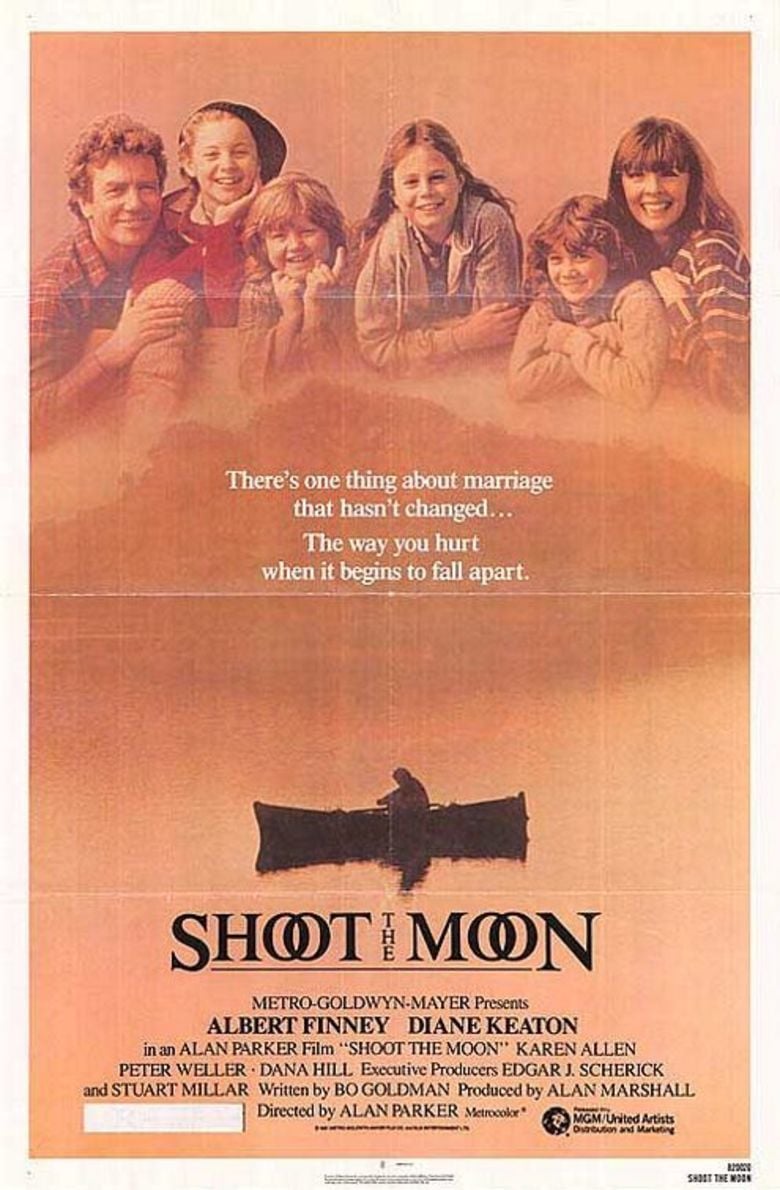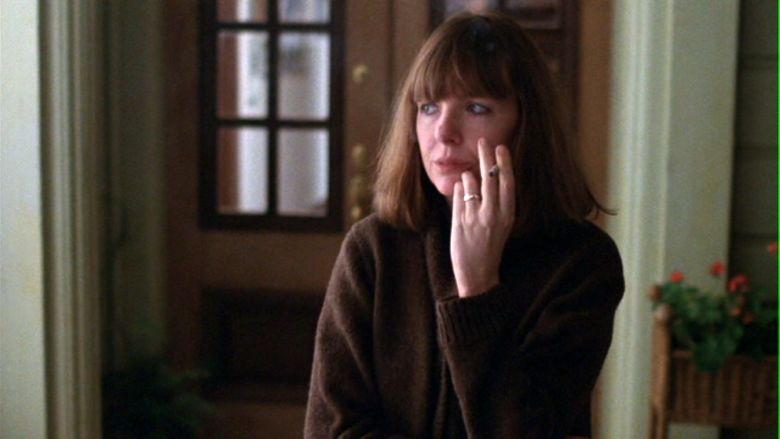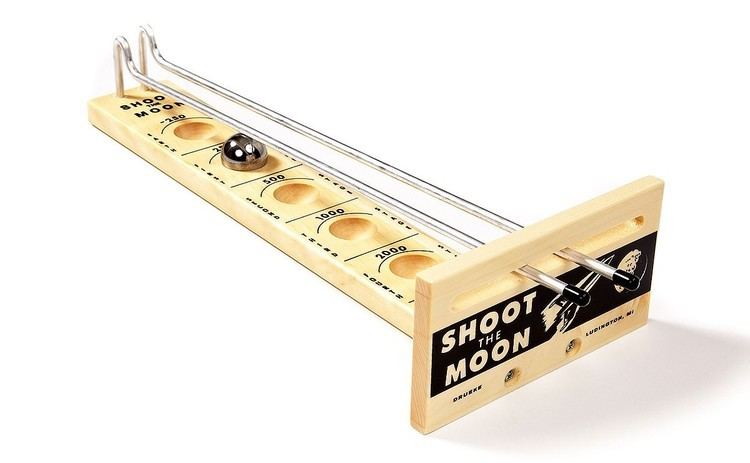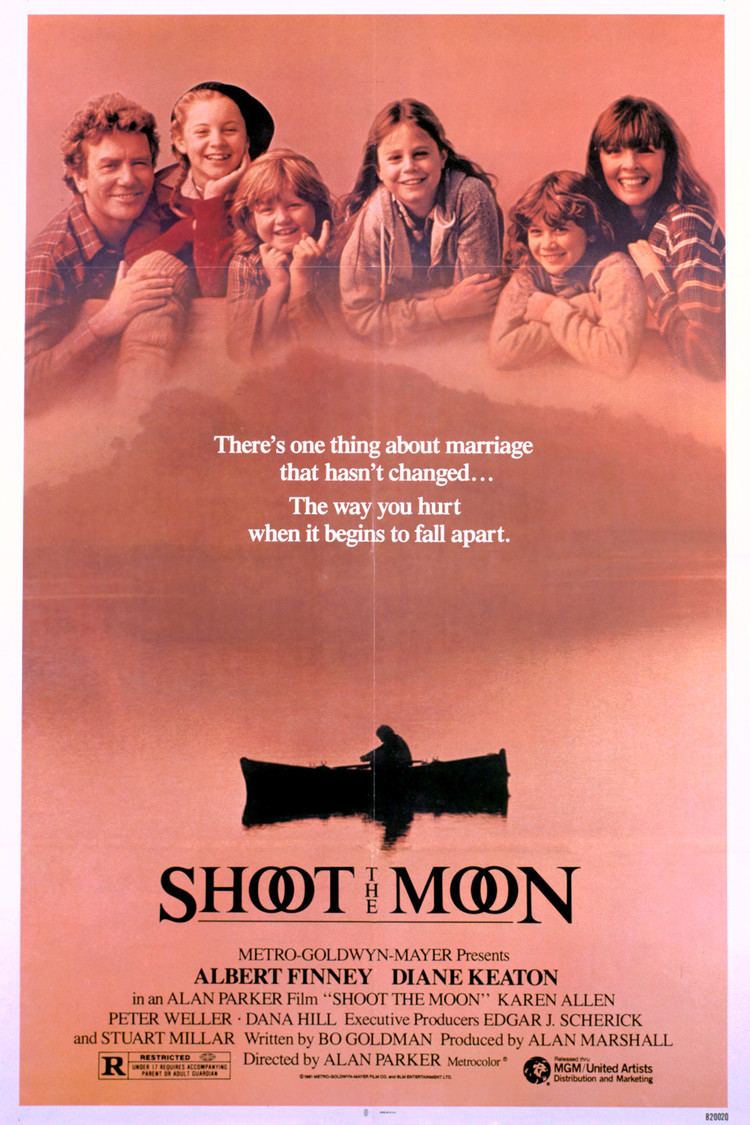Shoot the Moon
8.2 /10 1 Votes8.2
3.5/4 Roger Ebert Initial DVD release November 6, 2007 Duration Country United States | 7/10 IMDb 89% Rotten Tomatoes Genre Drama Budget 12 million USD Language English | |||||||||||||||||||||||||||||||||
 | ||||||||||||||||||||||||||||||||||
Release date February 19, 1982 (1982-02-19) Cast (George Dunlap), (Faith Dunlap), (Sandy), (Frank Henderson), (Sherry Dunlap), (Jill Dunlap) Similar movies Interstellar , Sexual Chronicles of a French Family , Bridesmaids , Student Services , The Lover , Young Girls of Wilko | ||||||||||||||||||||||||||||||||||
Shoot the moon 1982 official trailer albert finney diane keaton movie hd
Shoot the Moon is a 1982 American drama film directed by Alan Parker, and written by Bo Goldman. It stars Albert Finney, Diane Keaton, Karen Allen, Peter Weller and Dana Hill. Set in Marin County, California, the film follows George Dunlap (Finney) and his wife Faith (Keaton) as their deteriorating marriage, separation and love affairs devastate their four children.
Contents
- Shoot the moon 1982 official trailer albert finney diane keaton movie hd
- Plot
- Development
- Casting
- Filming
- Music
- Release
- Home media
- Critical response
- Accolades
- References

Goldman began work on the script in 1971, inspired by his own encounters with dysfunctional married couples, and spent several years trying to secure a major film studio to produce it. Parker learned of the script as he was developing Fame (1980), and later worked with Goldman to rewrite it. After an unsuccessful pre-production development at 20th Century Fox, Parker took the project to Metro-Goldwyn-Mayer (MGM), which provided a budget of $12 million. Principal photography commenced from January 1981 to April of that year, on locations in Marin County, California.

Upon release, Shoot the Moon received positive reviews from critics, but was a box office bomb, grossing $9.2 million during its North American theatrical run. It competed for the Palme d'Or at the 1982 Cannes Film Festival, and received two Golden Globe Award nominations for Best Actor – Drama (Finney) and Best Actress – Drama (Keaton).

Plot

In Marin County, California, George and Faith Dunlap are an unhappily married couple who live with their daughters Sherry, Jill, Marianne and Molly in a converted farmhouse that George has refurbished. George has begun an affair with Sandy, a single mother who calls him one night as he is preparing to attend an awards banquet in his honor. Sherry, the oldest of the four children, listens in on the phone conversation and soon grows suspicious of her father. The next morning, after the kids leave for school, Faith expresses her own suspicions to George, prompting him to leave and move into his beach house.
Faith falls into depression, but is elated when she meets Frank Henderson, a contractor she has hired to build a tennis court on the grove of the farmhouse. Sherry refuses to speak to her father, while Jill, Marianne and Molly visit George on weekends and meet Sandy, who is cynical towards them. One day, George visits the farmhouse and aggressively requests that he be able to give Sherry her birthday present, a typewriter. He grows frustrated upon meeting Frank and seeing the construction work being done to the yard. That night, George returns to the home, demanding that he be able to give Sherry her present. When Faith refuses to let him in, George breaks the door apart, pushes her out of the house, and blocks the broken door with a chair. After Sherry refuses the gift, George spanks her repeatedly. The other children try to fight him off, but George does not relent until after Sherry threatens him with a pair of scissors. After letting herself back into the house, Faith comforts a sobbing Sherry, and George leaves ashamed.
George and Faith go to court to begin the first stages of their divorce proceedings, which involves joint custody of the children. After the court hearing, Faith tells George that her father has been hospitalized. At the hospital, they both downplay the disintegration of their marriage, but Faith’s father senses that they are lying, and dies shortly thereafter. After the funeral, George finds Faith having dinner at a restaurant and joins her. They have a heated, passionate exchange, arguing about their relationship before getting drunk. They then go to a hotel room, where Faith and the children are staying, and have sex. After Sherry enters Faith's bedroom and finds them laying in bed, Faith asks George to leave.
Following completion of the tennis court, Faith and Frank throw an outdoor party at the farmhouse. Sherry scorns her mother for having sex with George and Frank before running away. She runs to George's beach house where she sees her father playing a game of Hearts with Sandy and her son. George looks out the window and sees Sherry sitting on a pier. He goes to comfort her and as they reconcile, he gives Sherry the typewriter.
George returns Sherry back to the farmhouse, where Faith invites him to visit the tennis court and meet the guests. Under a seemingly friendly facade, George praises Frank for his work on the tennis court. He then goes into his car and crashes into the tennis court repeatedly until it is completely demolished. Enraged, Frank pulls George out of the car and beats him relentlessly before walking away. As the children try to comfort him, George reaches out his hand and calls out for Faith, who looks down at him unfazed.
Development
The script for Shoot the Moon was originally developed by Bo Goldman under the working title Switching, and was his first attempt at writing a screenplay. Goldman began work the script in 1971, influenced by his own encounters with dysfunctional married couples and the impact their disputes had on their children. "When I started to write this screenplay years ago," he said, "I looked around me and all the marriages were collapsing, and the real victims of these marital wars were the children."
For several years, Goldman tried to sell his script, without success. Eventually, the script was picked up 20th Century Fox after the commercial success of Star Wars (1977). Alan Ladd, Jr., president of Fox, sent the script to Alan Parker, as the director was beginning pre-production on Fame (1980). After filming Fame, Parker met with Goldman, and the two worked together to rewrite the script. Among the changes, they moved the story from New York City to Marin County, California, and retitled the script to Shoot the Moon, a metaphoric title that referenced the move of "shooting the moon" in the card game Hearts. After Ladd was fired from Fox in 1979, Parker discussed the project Sherry Lansing, head of production for the studio. Although Parker and producer Alan Marshall had started pre-production work themselves, Lansing did want to spend the $12 million budget requested to make the film. Parker then discussed the project with David Begelman, head of Metro-Goldwyn-Mayer (MGM), who agreed to green-light the film on the conditions that Parker stay on budget and secure Diane Keaton, a sought-after actress, in a leading role.
Casting
In their search for actors, Parker and casting director Juliet Taylor held open casting calls in San Francisco, Los Angeles and New York City. For the role of George Dunlap, Parker first approached Jack Nicholson, who declined due to the script's subject matter. Parker then approached English film and stage actor Albert Finney, whom he had admired. On portraying George, Finney said, "It required personal acting; I had to dig into myself. When you have to expose yourself and use your own vulnerability, you can get a little near the edge. Scenes where Diane Keaton and I really have to go at each other reminded me of times when my own behavior has been monstrous."
Diane Keaton was cast as Faith Dunlap, George's wife. Parker had first discussed the role with her as the actress was preparing to film Reds (1981). He also discussed the project with Meryl Streep, who declined due to her pregnancy. Keaton agreed to star in the film after the project was taken to MGM. She described the film as "the war of a man and a woman who are breaking up and how the woman is crushed by this man going off an having an affair with someone else."
Appearing as George and Faith's four children are Dana Hill as Sherry, Tracey Gold as Marianne, Viveka Davis as Jill and Tina Yothers as Molly. Of the four children, only Hill was an established actress, while the remaining three were making their feature film debuts. Karen Allen secured the role of Sandy, George's mistress, after filming Raiders of the Lost Ark (1981).
Filming
Principal photography commenced on January 15, 1981 with a budget of $12 million. During the film's pre-production development at 20th Century Fox, Parker, Marshall and production designer Geoffrey Kirkland spent several months searching for houses to depict the Dunlap family home. They discovered the Roy Ranch House, an abandoned, 114-year-old clapboard ranch house located near the San Geronimo Golf Course in San Francisco. After deeming the golf course a difficult filming location, the production dismantled the house into four pieces, which were then transported to the Nicasio Valley region of Marin County, California. They spent six months restoring and decorating the house, as well as constructing a driveway, gardens and a tennis court.
Scenes set in Sandy's beach house were filmed in Stinson Beach, California. George and Faith's divorce proceeding was filmed at the Napa County Courthouse Plaza in Napa, California. The filmmakers also shot scenes at the Wolf House, Jack London's estate in Glen Ellen, California. In San Francisco, the production shot scenes at the Fairmont Hotel in San Jose, California, California Street, the San Francisco–Oakland Bay Bridge, Sea Cliff and St. Joseph's Hospital. Principal photography concluded on April 9, 1981 after 62 days of filming. Parker spent six months editing the film in London, England with 300,000 feet of film.
Music
Shoot the Moon does not feature an original film score; it was Parker's decision not to have a conventional score after working on Fame, a musical. Goldman selected "Don't Blame Me" from MGM's library of songs to be used in the film. The song is featured as a minimalist piano score that acts as a leitmotif. Parker stated, "I had it played on a piano with one finger—like a child would play, with innocent simplicity." The film also features pre-existing songs, including "Play with Fire" performed by The Rolling Stones and "Still the Same" performed by Bob Seger. Parker explained that he had the songs "selfishly chosen because they were contemporary songs that meant a lot to me personally."
Release
After post-production had concluded in October 1981, Parker had planned to release the film before the end of the year for awards consideration. However, a clause in Keaton's contract stipulated that the film could not be released until a year later to avoid competition with her previous film Reds. MGM gave Shoot the Moon a platform release, first releasing it in New York City, Toronto and Los Angeles on January 22, 1982. The film was released nationwide on February 19, 1982. It was a box office bomb, grossing $9,217,530 against a production budget of $12 million.
Home media
In 1986, the distribution rights to the film were transferred to Turner Entertainment, which acquired MGM's pre-May 1986 library of feature films. Currently, the rights are owned by Warner Bros., after its parent company Time Warner acquired Turner's library of MGM films in 1996. Shoot the Moon was released on DVD on November 6, 2007, by Warner Home Video. Special features include an audio commentary by Parker and Goldman, and the film's theatrical trailer.
Critical response
Shoot the Moon received generally positive reviews from critics. The review aggregation website Rotten Tomatoes sampled 9 reviews, and gave the film a score of 89%, with an average score of 7.5 out of 10.
David Denby, writing for New York magazine, called it "a rare honest movie about marriage [that] turns commonplaces into something vibrant and funny." Pauline Kael of The New Yorker wrote that Shoot the Moon "is perhaps the most revealing American movie of the era." Roger Ebert of the Chicago Sun-Times awarded the film three-and-a-half stars out of four, writing, "Despite its flaws, despite its gaps, despite two key scenes that are dreadfully wrong, Shoot the Moon contains a raw emotional power of the sort we rarely see in domestic dramas." Vincent Canby, writing for The New York Times, stated, "At its best, Shoot the Moon is as spare and as sharp in its detail as fine prose and as continuously surprising. Like the film adaptations of Ordinary People and Kramer vs. Kramer, it's a domestic comedy of sometimes terrifying implications, not about dolts but intelligent, thinking beings." Gene Siskel of the Chicago Tribune, wrote that the film was "an exceptionally strong family drama, with enough surprises to qualify as lifelike."
Accolades
Following its release, Shoot the Moon received several awards and nominations, with particular recognition for Finney and Keaton's performances. In May 1982, the film competed for the Palme d'Or at the 1982 Cannes Film Festival. It was one of two films directed by Parker to appear at the festival, the other being Pink Floyd – The Wall (1982), which was shown out of competition. At the 41st Golden Globe Awards, the film received two nominations for Best Actor – Drama (Finney) and Best Actress – Drama (Keaton) At the 36th British Academy Film Awards, Finney received a BAFTA Award nomination for Best Actor, but lost to Ben Kingsley, who won for Gandhi (1982).
References
Shoot the Moon WikipediaShoot the Moon (film) IMDbShoot the Moon (film) Roger EbertShoot the Moon (film) Rotten TomatoesShoot the Moon themoviedb.org
